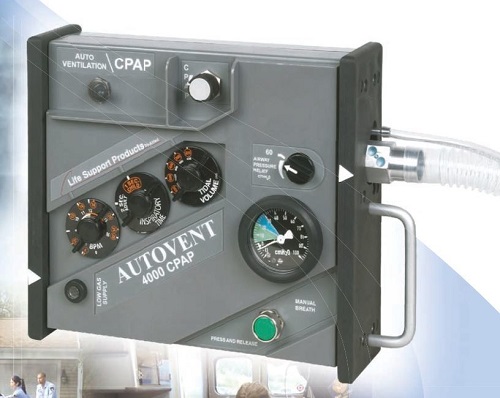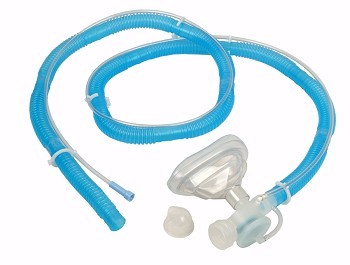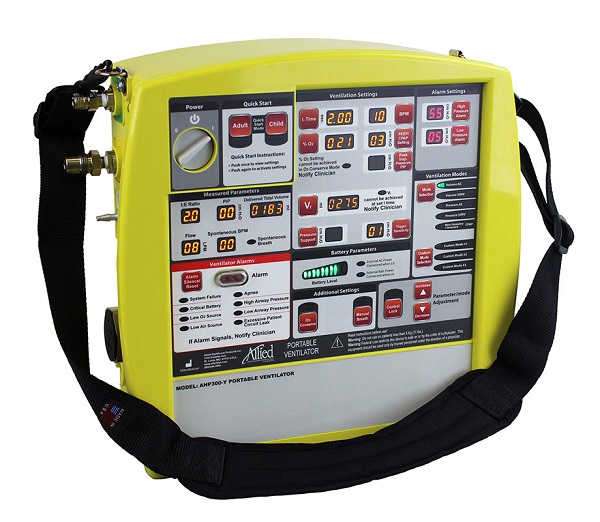By: USA Medical and Surgical Supplies
Published: USA Medical and Surgical Supplies
Date: February 6, 2019
Portable Ventilators Improve Critical Care Transportation
When it comes to critical care transportation, one of the key pieces of equipment to have on-hand is a portable ventilator. In addition to oxygenation, perfusion, and circulation, ventilation is one of the vital functions that must be sustained while transporting a patient to a critical care facility. In fact, some would assert that ventilation–the movement of air in and out of the lungs–is the most important.
6 Ways Portable Ventilators Improve Critical Care Transportation
1. Reduces Transport-Related Adverse Events
2. Provides Control of Tidal Volume and Respiratory Rate
3. Monitors Time for Medical Treatments, Drugs, Surgery, and Procedures
4. Helps Guarantee Patient Arrives Safely at Destination
5. Monitors Oxygen Levels
6. Allows Rescue Team to Attend to Other Patient Needs
Since the U.S. Food and Drug Administration’s 2001 approval of portable ventilators, medical staff and rescue teams have come to rely on these devices to provide the highest level of patient care during transport. Ventilator transport is often needed when patients are taken directly from emergency or accident sites to a critical care facility.
What is a Portable Transport Ventilator?
A portable transport ventilator is a device used for the artificial ventilation of the lungs. It uses positive pressure to pump fresh air into the patient’s airway to ensure the patient’s safety throughout the vulnerable transport period. Portable medical ventilators may be hand-operated or machine-driven. The more technical ventilators have many automatic sensors and settings and are fairly sophisticated in terms of their abilities to control and monitor airflow to the lungs.
Many times, intensive care patients who are connected to hospital ventilators must be moved–either to a different location within the same hospital or to a different facility. In these cases, the medical team must provide appropriate ventilator care during transport in order to protect the patient’s health and well-being. Portable medical ventilators are commonly used with pediatric patients and neonatal patients, who often are moved both within facilities and among different treatment centers while needing ventilation and monitored breathing.
When purchasing a portable ventilator machine, look for a variety of options with a variety of modes and advanced alarm and monitoring capabilities. Sophisticated modern transport ventilators provide precise control of oxygen concentration, which reduces the risk of hyperoxia or hypoxia. In addition, major improvements in battery life–plus the ability to hot-swap an internal battery during transport–have also all but eliminated any power concerns. Even the most sophisticated versions are equipped with an intuitive user interface. Additionally, the advanced sensors, alarm and monitoring capabilities available in today’s portable ventilators make them the preferred choice of many professional organizations as the endorsed standard of care for all hospital transports.
Some transport ventilators, such as the AutoVent 4000 transport ventilator, are available with CPAP functionality. Many transport ventilators like the AutoVent 4000 transport ventilator are pneumatically powered, durable and around 5 lbs. or less. Transport ventilators typically have independent settings for the critical ventilation parameters of Breaths Per Minute, Inspiratory Time, Tidal Volume, and Airway Pressure Relief.

How Does a Portable Ventilator Work?The first transport ventilators were developed after the realization that manual ventilation–typically delivered through a bag-valve device–was inadequate in many circumstances and even harmful to some patients. The first transport ventilators were cumbersome and often hampered by their excessive weight and their limited battery power. Early difficulties were largely related to limited oxygen, inadvertent disconnections, and improperly trained personnel. Fortunately, technology has improved greatly since then.
Portable ventilation takes place either by volume- or pressure-controlled modes. Volume-controlled versions are designed to achieve a programmed tidal volume with each ventilation at the appropriate pressure within a safe limit for the patient. Conversely, pressure-controlled modes deliver ventilations until a set pressure is reached, with tidal volume regulated by both lung compliance and airway resistance.
Controlled ventilation occurs when everything associated with respiration technically is managed by the rescue or care team. It requires a dose of respiratory gas specifically calibrated for the patient’s age, weight, size, and particular condition–which is best accomplished through the use of a portable ventilator machine. The device is lightweight, easy to operate, and combines the functionality of an ICU-grade ventilator with the compactness and ruggedness befitting an EMS transport ventilator.
6 Ways a Portable Ventilator Improves Critical Care Transportation
Let’s take a closer look at some of the benefits a medical portable ventilator brings to patients during transport:
1. Reduces Transport-Related Adverse Events
Transporting patients brings inherent risks that do not apply within a stationary health care setting. Typically, patients being transported are already vulnerable due to their physiological conditions, and they tend to become more unstable when moved. Transport-related adverse events are not uncommon, and in fact, may happen with rates as high as 68 percent. This combination of skilled personnel and the right equipment is one of the key components the medical care team must have to ensure patient safety, and portable ventilators greatly reduce the likelihood of transport-related adverse events. For some patients–including ICU patients requiring high levels of medical ventilator support–using a portable transport ventilator is standard protocol in many health care practices.
2. Provides Control of Tidal Volume and Respiratory Rate
Today, most critical care/transport ventilators have the capacity to essentially duplicate the sophisticated functionality of acute care or hospital ventilators. In addition, most can provide continuous positive airway pressure (CPAP) and bilevel positive airway pressure (BiPAP) and are appropriate for both EMS and intensive care patients during transport.
3. Monitors Time for Medical Treatments, Drugs, Surgery, and Procedures
Using a medical portable ventilator during transport provides necessary medical ventilation support to patients and helps stabilize their vital signs. This allows the team to provide the appropriate medical treatment that can address the root cause of the patient’s condition – whether that be drugs, surgery or other medical procedures.
4. Helps Guarantee Patient Arrives Safely at Destination
Patients within transport vehicles are often at their most vulnerable, and portable ventilators help keep patients stable. This helps ensure that they arrive at their next location of medical care safely and in the most stable condition possible. Portable medical ventilators provide consistent support and oxygen concentration during a variety of medical and environmental conditions. This allows time to provide the appropriate level of mechanical support for a wide variety of patient types and conditions, which increases the chances of ensuring that patients are transported safely to their medical destinations.
5. Monitors Oxygen Levels
During critical care transport, a portable ventilator for breathing can provide sufficient oxygen to meet patient needs, along with allowing the team to continuously monitor the patient’s levels and adjust as necessary. This continuous monitoring allows the medical team to carefully balance the patient’s oxygen requirements with any adverse effects of oxygen, such ss oxygen toxicity or hyperoxia. The care team must carry out regular inspections and audits to ensure that each transport vehicle is always stocked with enough oxygen to last the entire expected time of the transfer, plus have a backup reserve of at least one to two additional hours.
6. Allows Rescue Team to Attend to Other Patient Needs
Before the proliferation of portable automatic ventilators, the standard of care for emergency medical teams was to deliver oxygen manually through a bag-valve device. However, extensive research has shown that prolonged manual ventilation is harmful to the patient, even to the point of contributing to patient mortality. The use of an automatic transport ventilator allows emergency workers to attend to additional patient needs since they are not directly involved in the manual delivery of oxygen.
How to Use a Portable Ventilator
Above all, you must make sure the medical team is trained and proficient on how to best use the portable ventilators purchased. When using a portable ventilator, several parameters must be set correctly in order to help patients most effectively. The simplest versions use a standard control mode, while more sophisticated units can offer a wide range of ventilation modes. Some models also include an intermittent mandatory ventilation (IMV) mode, which allows the patient to take spontaneous breaths on their own without triggering a positive pressure cycle. If a patient can maintain appropriate oxygenation with IMV, this is the preferred setting to use.
The assist mode is appropriate for patients with negative pressure forces of their own. The portable ventilator will deliver all positive pressure ventilations with each cycle. Conversely, the control mode should be used with patients who are completely apneic, including those who are being sustained on neuromuscular blocking agents. This mode delivers a set level of positive pressure, which prevents the patient from triggering any additional breaths.
Medical teams should be fully trained on the correct operation of the automatic transport ventilator you choose. In addition, at least one member of the team should be charged with ensuring that batteries are always sufficiently charged and that ancillary supplies are comprehensively stocked, such as ventilator circuits. All those participating in patient transfer and care should know where appropriate equipment is stored, along with knowing how to appropriately use it. All portable ventilator manufacturers provide operating manuals, and some provide video training and in-service training.

Portable Ventilators for Patient Transport
A portable transport ventilator is a key piece of equipment that helps provide the best possible patient care during transport to critical care facilities. The device helps emergency rescue teams save lives and protects intensive care patients who must be moved to a different location. The health care team should become familiar with the applications of the transport ventilators purchased for them. Whether used as therapy, in ambulances, helicopters, or airplanes to treat neonatal, pediatric or adult patients, portable ventilators can help ensure the safety, health, and well-being of every patient they serve.
Transport Ventilator Price
Like many medical equipment devices, prices can have a wide range of costs based on the technology used in the transport ventilator and included features. As a general range, most transport ventilators are in the $2K -$5K price range.
Portal Ventilators with a Battery
Many modern, well-featured portal ventilators have an internal battery providing power wherever needed. The battery life is generally in the range of 5 – 8 hours. Some portable ventilators like the Allied Healthcare Portable Mass Casualty Ventilator MCV200 can be operated on compressed gas, DC power, or AC power, providing emergency medical teams with multiple options to treat patients.
Source: https://www.usamedicalsurgical.com/blog/portable-ventilators-improve-critical-care-transports/
Image: https://cdn10.bigcommerce.com/s-p10g1rn/product_images/uploaded_images/portable-ventilator.jpg?t=1549511262
Analysis:
The purpose of this article addresses the concept and practice of a portable ventilator vs. a stationary ventilator. When specifically addressing the transportation of a patient through the process of an IHT, portable ventilators can be utilized to preform the functions of oxygenation, perfusion, and circulation. In comparison, portable ventilators emphasize on the ability to take the device on-the-go without bringing any addition bulk or clutter that would be present with a stationary ventilator, reducing the risk of airway disruption during movement/transport. As outlined in the various sections, the benefits of a portable ventilator extend to the ability to monitor and control the levels of the patient, attend to other needs of the patient, and stabilize the patient during transportation as opposed to a stationary ventilator. This area of focus connects directly to the problem identified of reaching the risks that arise when disconnecting and reconnecting between the stationary ventilators and portable ventilators. Understanding to what extent portable ventilators need to function and the means in which the team members interact with the portable ventilator will highlight key points that will guide my design in relation to functionally and potential ergonomic factors.




